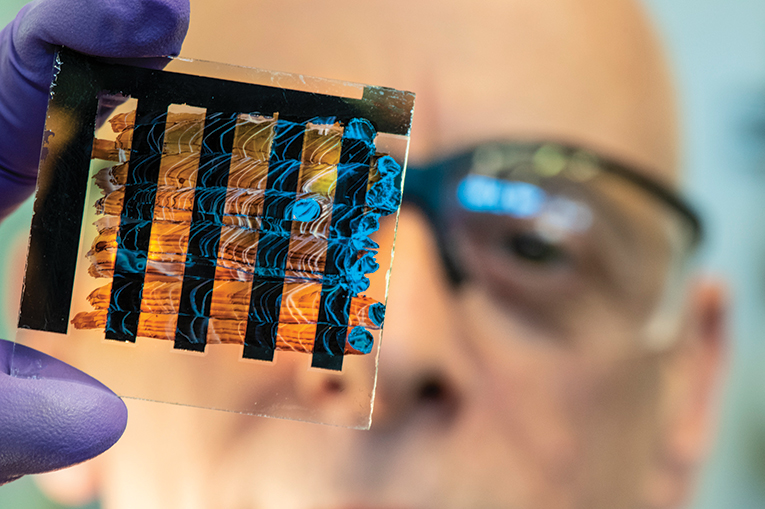For this issue's “Powherful Forces” section, we had the privilege of interviewing Dr. Becca Jones-Albertus, who is the Solar Energy Technologies office director within the Office of Energy Efficiency and Renewable Energy
As a high school student, Dr. Becca Jones-Albertus was fascinated with solar energy, but not many people in her orbit knew what solar power was. She pursued her passion, earning a B.S.E. from Princeton University, followed by a Ph.D. in materials science and engineering from U.C., Berkeley. She even went to Tibet to explore how remote communities could install and repair existing solar panels to meet their lighting needs.
After finishing her doctorate, she joined Solar Junction, a startup company that developed new technology for high-efficiency solar cells. There, Jones-Albertus was part of a team that set two world records for the most efficient solar cells in the world and broke technology barriers for the material the company developed. As gratifying as the experience was, Jones-Albertus found herself wanting a stronger connection to “the bigger picture.” So, after five years with Solar Junction, she left her position for the U.S. Department of Energy’s (DOE) Office of Energy Efficiency and Renewable Energy Solar Energy Technologies Office (SETO), to become the photovoltaics R&D program manager.
It didn’t take long for Jones-Albertus to feel like she had found the perfect landing place. Not only was she able to focus more on a big-picture mission; she saw her work as an opportunity to have an impact while also leveraging her technical expertise. Within three years of joining DOE, Jones-Albertus was promoted to SETO’s deputy director. Now, six years later, Jones-Albertus has taken on her third role with DOE, recently being appointed SETO’s director.
Today, Jones-Albertus oversees teams that support early-stage research and development projects in photovoltaics, concentrating solar-thermal power, and systems integration technologies, as well as soft (non-hardware) costs and moving technology to market. Of the 400 projects underway across the country, some could have market impact within a couple of years, while others remain 10 to 20 years out.
Jones-Albertus also spends time updating Congressional staff and DOE’s political leadership about SETO’s work, and she engages with a broad array of other stakeholders. “It’s important that we talk with industry partners and other relevant stakeholders to understand their needs,” she says. “We need to make sure the research we’re funding is as relevant and impactful as possible. As solar becomes more of a mainstream technology, it becomes even more important to look at the interactions it has with other technologies to ensure all pieces are working together effectively to support the grid.”
Asked what Jones-Albertus finds the most compelling about her work, she points to the industry’s transformation. “We’ve seen such dramatic decline in solar energy costs,” she says. “The cost of solar modules themselves has fallen by a factor of nearly 10 over the past decade. It takes many separate pieces of innovation to achieve these kinds of cost reductions; improvements in efficiency are one important example of that innovation.”

A flexible all-perovskite tandem solar cell.
Photo by Dennis Schroeder / NREL.
While more consumers are considering solar as a viable energy source, Jones-Albertus says the industry continues to face challenges. “We need to figure out ways to couple solar with storage and other technologies to enable its supply of electricity to be better aligned with when we need power, but also, solar needs to utilize its ability to support the reliability of the grid.” To that end, SETO funds projects focused on innovations in power electronics and other communication technologies. SETO also collaborates with other DOE offices, including the Office of Electricity, to develop capabilities for solar inverters to restart segments of the grid in the event of a power outage.
Further, Jones-Albertus explains, “As technological advances make it cheaper to buy solar power, there are new markets for solar, which have their own challenges. For example, there are issues with siting solar plants where communities are concerned about what solar might do to the character of the land.”
Additionally, Jones-Albertus says there are issues around the lack of access to solar power. “While solar today is very affordable in many parts of the United States, more than half of Americans don’t own a home or have a rooftop that is suitable for solar,” she says. “And for solar to be affordable, you have to have affordable financing mechanisms, such as drawing on your own savings or low-interest loans. These options are not accessible to large shares of Americans.”
To address these types of challenges, DOE created the National Community Solar Partnership (NCSP), a coalition of community solar stakeholders working on expanding access to affordable solar power. With the NCSP, DOE is looking at new models for community solar that would allow participants to enjoy the benefits of solar energy as if they have solar panels installed on their homes, even though it is being generated by a large solar plant.
For those interested in emerging trends in the solar space, Jones-Albertus says they can keep their eye on perovskite technology. This solar cell technology has climbed in efficiency faster than any solar technology she has seen to date. Although perovskite solar cells have the potential to create low-cost solar power, they must undergo significant additional research to improve their lifetime and reliability. In the meantime, perovskite cells show promise that they can be integrated with existing solar technology in a tandem solar cell, which is made of two materials that each absorb different parts of sunlight to extract energy more efficiently than a standard, single-junction solar cell.
When solar energy first piqued Jones Albertus’ curiosity, solar power was less than one one-hundredth of a percent of the energy supply in the United States. Today, with solar making up 10 percent of the energy supply in several states, and nearly 20 percent of the energy supply in California, Jones-Albertus can talk about her work without having to explain solar power.

NREL researcher David Moore holds a perovskite ink painted cell. NREL researchers have developed an interdigitated back
contact solar cell design in which the metals and transport materials are solution-processed by either inkjet or spray coating.
Photo by Dennis Schroeder / NREL.
“I no longer have to tell anybody what solar means,” says Jones-Albertus. “Today, we’re looking at the possibility that solar energy could make up a large share of our electricity generation – it could change the way we use electricity, and it could change the way consumers interact with their own electricity supply.”
What started as a fascination with solar power when Jones-Albertus was a teenager has evolved into rewarding work with the U.S. government agency that focuses on energy generation and distribution. Describing her career up to this point, Jones-Albertus says, “This has been an incredibly inspiring experience. It’s just amazing to be part of this rapid, rapid change, and I know we are far from the end of it.”
 Dr. Becca Jones-Albertus is the Solar Energy Technologies Office Director within the Office of Energy Efficiency and Renewable Energy, where she leads a team that supports early-stage research and development in the technology areas of photovoltaics, concentrating solar-thermal power and systems integration with the goal of improving the affordability, reliability, and performance of solar technologies on the grid.
Dr. Becca Jones-Albertus is the Solar Energy Technologies Office Director within the Office of Energy Efficiency and Renewable Energy, where she leads a team that supports early-stage research and development in the technology areas of photovoltaics, concentrating solar-thermal power and systems integration with the goal of improving the affordability, reliability, and performance of solar technologies on the grid.
Jones-Albertus has spent her career advancing solar technology, from fundamental research and development to manufacturing. Prior to joining the Department of Energy, she was at Solar Junction, where she led efforts developing the company’s two-time world record solar cells and transitioning the technology to manufacturing.
Jones-Albertus graduated magna cum laude from Princeton University with a B.S. in electrical engineering. She also holds an M.S. and Ph.D. in materials science and engineering from the University of California, Berkeley. She has more than 10 patents and 40 technical publications.






